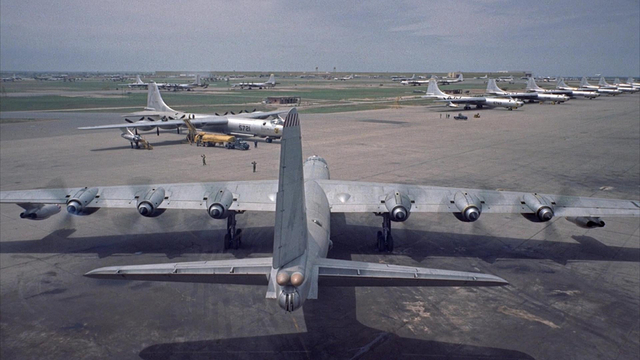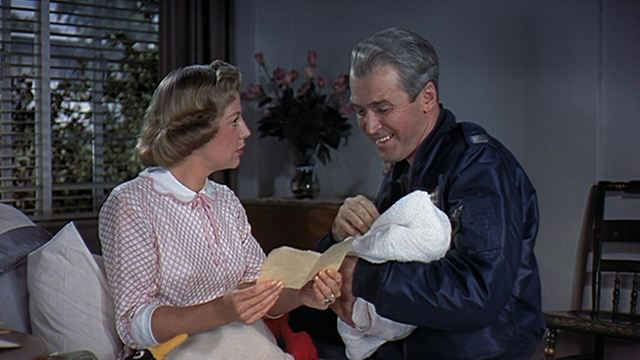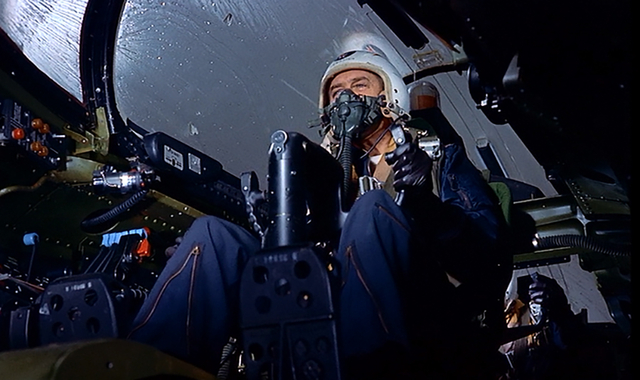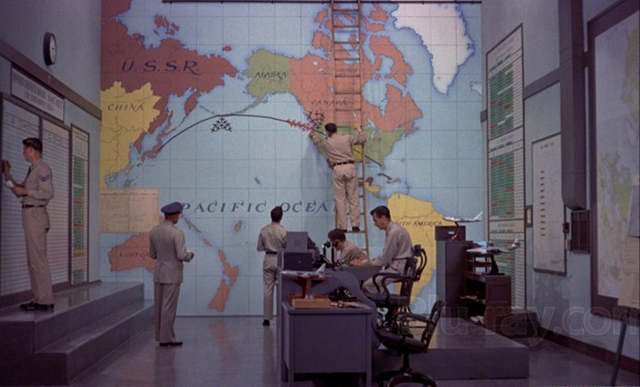The five year gap in Jimmy Stewart’s filmography between 1942 and 1946 was the most vivid and important period in his life, if you believe what the famously reticent and reserved movie star would say later. He spent it in uniform with the U.S. Army Air Force, much of it flying B-24 bombers with the Eighth Air Force over Europe. Interviewed by writer Jonathan Coe for the biography Jimmy Stewart: A Wonderful Life, the actor was asked to compare it to his career as one of the biggest stars in Hollywood for nearly half a century. Was it greater than that, Coe asked?
“Much greater,” Stewart said.
Several biographies of Stewart like to point out that he never made a war film after coming back from the war, including Jimmy Stewart: Bomber Pilot, an account of his time in the USAAF, written by Starr Smith, who served as an intelligence officer in the Eighth alongside Stewart. The actor is quoted as saying that war movies never really got the truth of war right.
It’s a great factoid, but isn’t really true: Stewart made two films for MGM set during the lead-up to the war before he entered the service – The Mortal Storm (1940) and Come Live With Me (1941), typical of the mixtures of melodrama and propaganda the studios made to support President Roosevelt’s persistent push for American entry into World War II. After the war he would split his time between genres with a heavy emphasis on westerns, but among them was Malaya (1949), with Stewart and Spencer Tracy smuggling rubber out of Japanese-occupied Southeast Asia, and The Mountain Road (1960), as an officer fighting the Japanese in China.
He would play a pilot, most famously his role as Charles Lindbergh in Billy Wilder’s The Spirit of St. Louis (1957) and in The Flight of the Phoenix (1965). But his most notable turn in a cinematic cockpit was a film that subtly mirrored his own life, 1955’s Strategic Air Command, an entry in the curious and indefinable genre of the Cold War picture.
We meet Stewart’s “Dutch” Holland at Al Lang Field in St. Petersburg, Florida, where he’s doing winter training as third baseman with the St. Louis Cardinals. He’s briefly distracted from the game when a B-36 “Peacemaker” from nearby MacDill Air Force Base flies over the field: Dutch looks up at the massive bomber enviously, which would be quiet foreshadowing if we hadn’t already seen an old war buddy of his, still in uniform and now a senior officer, sitting in the stands with Sally (June Allyson), Dutch’s new bride, and his father-in-law, a vicar.
Dutch holds a commission in the air force reserves, which he considered just an honorary title until the head of Strategic Air Command, General Hawkes (Frank Lovejoy playing a very thinly-disguised version of Gen. Curtis LeMay) decides that he needs to staff his understrength flight crews with veteran pilots like Dutch, who flew B-29s during the war.
Dutch is resistant and resentful but knows there’s nothing he can do to avoid losing 21 months of his baseball career – a precious two seasons that an older player can’t afford to discard. This echoes Stewart’s own status in the air force reserves, which eventually led to a promotion to brigadier general in 1957, but also Red Sox left fielder Ted Williams, a veteran Navy pilot who was recalled against his protests into the Marine Corps in 1952, serving in Korea and surviving the crash of his F9F Panther jet.
Dutch dreads breaking the news to Sally, who had only just finished decorating their first home together, but she seems to take it in stride, happy to support her husband in his duty – as long as it’s only for 21 months. And so Holland dejectedly makes his way to Carswell, a SAC base in Forth Worth, Texas, arriving in civilian clothes because his old brown uniform – worn while the US air force was still a part of the army – is out of date. He runs afoul of security and military bureaucracy and has an awkward first meeting with Gen. Hawkes, who terrorizes his men with constant drills and spot checks.
Strategic Air Command was directed by Anthony Mann, among the greatest of Hollywood’s journeyman directors, who would work with Stewart on eight films from Winchester ’73 to The Naked Spur, The Glenn Miller Story and The Man from Laramie. More importantly it was made with the full cooperation of the USAF and SAC, who gave Mann and his crew unprecedented access to air bases and planes, including the monstrous B-36 bomber that Dutch has to learn to fly after years on the ground.
The film has a palpable sense of awe as it approaches the B-36, sitting on the tarmac preparing for flight. The plane – the key to SAC’s mission of nuclear deterrence and counterstrike at the beginning of the Cold War – was already a relic when Mann’s cameras filmed it. It was originally conceived at the start of the ’40s, when the U.S. thought that Britain couldn’t hold out against a Nazi invasion, and would need a bomber with massive speed and range to fly from airfields on the East Coast and in the North Atlantic to hit targets in Germany.
What Consolidated Aircraft came up with was an inelegant as it was massive – a long cigar tube of a plane with a vast 230 foot wingspan, the largest of any plane in the USAF inventory. It was covered in guns and carried a crew of fifteen in two huge two-story compartments connected by an 83 foot tunnel; they were meant to work in shifts, since typical B-36 missions could take up to a day.
By the time it was the centerpiece of SAC operations its six huge rear-facing piston engines had been augmented by a further four (“six turning and four burning”) jet engines to help with takeoff and attack speed. Mann lingers outside the monstrous aircraft before Stewart’s Dutch climbs on board for his first flight on the B-36. Mann takes precious time as the crew goes through pre-flight checklists, and captures the plane from every possible angle as she taxis down the runway, gets airborne, and flies off into the clouds, the soundtrack heaving and sighing with romantic ardor.

Once in the air, Dutch learns that what he assumed was a quick take-off and landing is actually a flight to Alaska and back, and as the sun sets and rises again Mann makes us feel the length of even the most routine training mission in a bomber that was tasked with delivering nuclear bombs in vast fleets to cities and military facilities in the USSR, though the film takes pains to never explicitly describe the B-36’s primary mission for SAC, only mentioning the A-bomb once.
By the time the movie was released, the B-36 was already being retired from SAC service. Three-hundred and eighty four were produced, but only four remain, on static display in museums in California, Ohio, Arizona and Nebraska. The footage of the B-36 in Strategic Air Command is the greatest memorial to the plane’s service, filmed in VistaVision with more detail and fidelity than most obsolete hardware of the Cold War period would ever leave behind.
It’s hard not to regard Strategic Air Command as a propaganda film, made during peacetime (though the timeframe of the film, roughly from 1951 to 1953, takes in the whole of the Korean War, which never gets mentioned in the picture.) From Victor Young’s jingoistic march during the opening credits to the besotted camerawork whenever the film gets near any aircraft, it’s hard not to consider Mann’s picture as a big-budget recruitment film, especially when Lovejoy’s Hawkes/LeMay repeatedly talks about his constant need for recruits to crew and fly SAC’s 24/7 missions, designed around constant vigilance and readiness.

But it’s a funny sort of propaganda picture; from the moment Dutch climbs aboard the B-36, he meets crew who complain about being torn from peaceful, profitable civilian life back into uniform and serviceman’s pay. Dutch and Sally struggle against indifferent and occasionally inefficient bureaucracy while trying to carve out domestic life on base. To be fair, there were millions of Americans in the film’s potential audience who had recent memories of military life; they would have known if it was being soft-soaped for their benefit. They might even, a decade later, have felt nostalgic about their lives during the war, in or out of uniform.
Even stranger is the film’s willingness to admit that these “peacetime” missions were as potentially dangerous as those flown during wartime, showcased in Dutch’s last flight in command of a B-36. The plane was a bit of a Rube Goldberg contraption by the time it saw frontline service, and had constant issues with fuel leaks and engine fires, such as the one that forces Dutch to order his crew to jump out while he tries to make a gear-up emergency landing on their approach to a SAC base in Thule, Greenland.
The scene is based on a real incident in 1953, when a B-36 went off course in a storm and crashed in Newfoundland. All of the 23 men on that plane were killed, including a brigadier general, but Dutch manages to save himself and the navigator who chooses to stay on board, surviving in the wrecked fuselage until a rescue team arrives.
Nursing a bruised shoulder and hitching a ride back to Carswell with Gen. Hawkes, Dutch is surreptitiously ushered into a hangar by the General to be shown the plane that would (briefly) succeed the B-36 as SAC’s main bomber – the sleek, swept-wing Boeing B-47.
In Jet Age Man: SAC B-47 and B52 Operations in the Early Cold War, author and veteran pilot Earl J. McGill describes the scene. “You can almost hear the church bells ringing as he looks on in awe, struck dumb by its sleek beauty and hidden power. The scene borders on schmaltzy to an extreme. It’s also true. I loved that airplane more than any other I’ve ever flown. Maybe I don’t want to remember otherwise, but I can’t recall a single B-47 aircraft commander who wasn’t love stricken by the big beautiful bird – even though it continually tried to kill us and too many times succeeded.”
The conflict in Strategic Air Command isn’t between Stewart’s Dutch and any Soviet, Chinese or North Korean pilot, as much as it’s a love triangle between Dutch, Sally, and flying, embodied in the futuristic B-47, with its bullet-like fuselage, dramatically pulled-back wings and their six jet engines. If the B-36 was undeniably a machine – a barracks, fortress and weapons system held aloft by its huge wings and ten engines – the B-47 was a spaceship, the USAF’s first true nuclear age jet bomber.
As love triangles go, it gets as torrid as it’s possible to be when one point of the triangle has eighteen rockets built into its tail. It was helpful that Stewart and June Allyson had experience playing husband and wife, in biopics like The Stratton Story (1949), with Stewart playing White Sox pitcher Monty Stratton, and Mann’s The Glenn Miller Story(1954), featuring Stewart as the big band leader whose plane disappeared mysteriously over the English Channel during the last year of World War II.

During Dutch’s 21 months of service Sally gives birth, moves house and redecorates as her husband is re-assigned, anticipating the day when his deployment is over and he can return to what’s left of his career with the Cardinals. When that day comes, however, Dutch has been won over by the mission of SAC and the rush of flying, especially when he moves into the cockpit of the B-47, with its much smaller crew of three and subsonic speed.
He volunteers to re-up, leaving behind baseball for a career in the military and the chance to fly all the time. This angers Sally, who wasn’t consulted in his decision, and she takes it out on Hawkes, accusing him of flattering and manipulating her husband. Dutch, for his part, doesn’t understand why his wife can’t understand the cause that he’s willing to serve.
“If there was a war going on you wouldn’t question any of this,” he tells her.
Their marriage looks like it’s on the rocks as he climbs into the cockpit for SAC’s most ambitious exercise in the film – the complete redeployment of its B-47 squadrons and their legions of support crew and equipment across the Pacific to forward operating bases in Japan.
These long-distance training sorties were grueling affairs, involving endless hours in the air and the then-novel business of mid-air refueling. With only a crew of three, there weren’t the same shift changes as on the B-36, and pilots would sit behind the controls and fight fatigue, compounded by the challenges of flying a plane as temperamental as the B-47.
The Stratojet was an unpredictable aircraft whose wingtips would flex up to 17 feet in flight; it was nearly free of drag and could accelerate suddenly, while its nose would send the plane into a dive if the pilot didn’t pull back on the throttle. Its designers were still working from propeller engine rulebooks, which meant its wings pulled apart when it achieved critical speeds, and while taking off was a rush, with six jet and eighteen rockets firing away, landing was a nightmare, as pilots fought to create as much drag as possible before the chute in the tail could deploy.

The B-47 had an accident rate of ten per cent, which means the plane itself was far more dangerous to its crews than any of the enemies it never really met during its brief service with SAC. It was the shiny new beast at SAC when Mann’s film was released, but it was being phased out of frontline squadrons four years later, when the larger, uglier, but more reliable B-52 was beginning what would become its incredibly long service. If a plane this dangerous was deployed by the air force today, it would be a media scandal and the subject of congressional inquiries.
The USAF purchased over 2,000 B-47s; 23 survive today, none of them airworthy.
In the end, Dutch gives (nearly) his all in service to SAC; his shoulder injury is more serious than it looked, and he ignores it until his arm seizes up on the way to Japan and forces him to make an emergency landing with the assistance of his co-pilot. Arriving back at the base, he’s informed by Hawkes that he’s being honorably discharged; his flying days are over, along with his baseball career – hopefully the Cardinals can use a new manager.
“Is that it?” Sally asks, and indeed it all ends quite abruptly, though not before Dutch, Hawkes and Sally look out the window of the general’s office to gaze up in awe at a new flight of B-47s overhead.

Nine years later LeMay and SAC would be satirized by Stanley Kubrick in Dr. Strangelove, as embodied by Sterling Hayden’s Gen. Jack D. Ripper and George C. Scott’s Gen. Buck Turgidson. LeMay and the doctrine of Mutually Assured Destruction (M.A.D. – the worst acronym in use until the Committee to Re-Elect the President, or CREEP) were being regarded as immoral and monstrous. The noble mission that Hawkes presents to Dutch in Strategic Air Command had dissolved into a suicidal farce likely to end catastrophically in misunderstanding and error, as depicted in Miracle Mile (1989), the first film I reviewed for this column exactly a year ago.
This trajectory is hinted at in Mann’s film, with Dutch’s protest that Sally wouldn’t question him if they were involved in a real war. It was always a hard sell to make the Cold War feel like a real war, especially since its battles were fought in proxy wars and its victories were hard to define. People still debate today whether the B-36 would have been able to complete its missions if the cold war turned hot: would the lumbering giants have really flown higher than Soviet fighters, and would enough of them have gotten through to make a worthwhile counterstrike?
It didn’t matter anymore when bombers gave way to missiles – faster, higher, harder to shoot down, and liberated from human agency once they left their silos. In any case one side eventually blinked and LeMay’s victory, never really acknowledged by the other side, is morally impossible to celebrate by the very contemporary standards we use to judge that long-ago first decade of the Cold War. In the end we all stood there like Sally asking “Is that it?” as we stared at an empty sky.
Mark Steyn Club members can let Rick know what they think by logging in and sharing in the comments below, as access to the comments section is one of many benefits that comes along with membership in the Mark Steyn Club.
© 2022 Mark Steyn Enterprises (US) Inc. All rights reserved.
No part of this website or any of its contents may be reproduced, copied, modified or adapted, without the prior written consent of Mark Steyn Enterprises.
If you’re a member of The Mark Steyn Club and you take issue with this article, then have at it in our comments section.
Source link
Author






